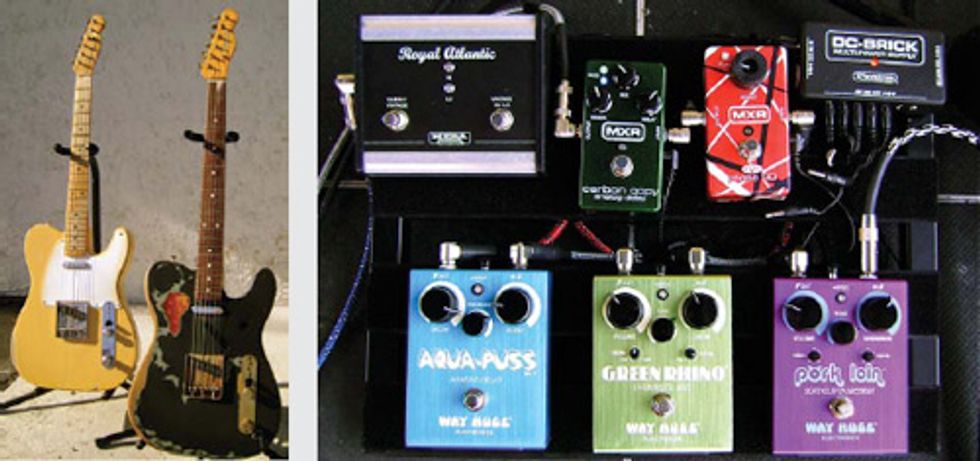Let's consider the pros and cons of new and old guitars.

LEFT: Twang Brothers: A blonde Fender Road Worn ’50s Telecaster and a Fender Joe Strummer Telecaster show a vintage treatment on contemporary guitars. RIGHT: Analog pedals wired with Spectraflex Original Series cables mounted on a Pedaltrain Jr. (Top row) Mesa/Boogie Royal Atlantic footswitch, MXR Carbon Copy Delay, MXR EVH Phase 90, Dunlop DC Brick power supply. (Bottom row) Aqua-Puss delay, Green Rhino MkII overdrive, and Pork Loin overdrive, all made by Way Huge Electronics.
After 60 years of countless alterations, both outrageous and conservative, the electric guitar is still basically wood and metal held together by glue and some more metal, just like its vintage ancestors. The emergence of the reissue and the "relic" in the marketplace has put a cost-effective twist on a buyer’s ability to obtain retro looks and tones without a vintage price tag.
I like vintage instruments and appreciate their history, but I have found modern instruments to be far more consistent and reliable, which is more important on tour. The biggest problem I encounter with vintage instruments are worn-out parts. Noisy electronics, and worn frets and bone nuts are just a couple of the issues that often need to be addressed on vintage pieces. The second you start tampering with a vintage guitar—refretting it or breaking a solder joint to swap out a pot—you begin to jeopardize its value to a collector. An easy and cheap way around this is to buy a new guitar that has been relic’d.
Many people buy modern relic’d instruments for their feel and appearance, but I like them because they don’t have too much finish. I’ve found that less finish almost always equates to a richer sound, and this especially applies to single-coil guitars. The guitar seems to vibrate more freely when its not bathed in a bunch of polyurethane. I bought my Fender Joe Strummer Telecaster because it has a minimal amount of finish. I use this guitar for darker sounds and for big, loud overdriven chords. I swapped out the factory saddles with thicker ones to beef up the sound, and the guitar is strung with a .011 set of SIT Power Groove Pure Nickel strings. As you’ll notice in the photo, I also removed the pickguard. Taking off a Tele pickguard really seems to change how the strings feel when they vibrate and the tone takes on a more raw sound. The Strummer also has a set of Lollar pickups.
My Fender Road Worn ’50s Telecaster is completely stock, and it too has very little finish on the body and neck. The only thing I’ve changed since buying this Tele are the strings. I like this guitar to be as bright and springy sounding as possible, so I have it strung with .0095 gauge SIT Power Wound strings. Lighter strings produce more snap and bite, which is great for country lead playing. Continuing with the retro theme, I recently put together a pedalboard with all-analog effects. The entire board is powered by a Dunlop DC Brick I’ve had since I was a teenager. The Brick is dead quiet and never generates odd buzzes or hums. The Way Huge Pork Loin is one of the best Tube Screamer-style pedals I’ve used. It has a clean mix control that allows some really interesting blends between clean and overdriven tones.
The Green Rhino works well for rock rhythm guitar, but one of my favorite things is to use it for soaring leads. I roll the Rhino’s tone knob completely off and play with my Tele’s bridge pickup. The pickup allows the attack and clarity to stay intact and the pedal takes care of adding low end and smooth body.
I set the Aqua-Puss delay mainly for ’50s-style slap-back echo and use my MXR Carbon Copy for longer delays and ethereal sounds. To create a broad soundscape, I’ll set up an EVH Phase 90 between two delay pedals. The phaser is constantly moving through its stages of different tones, so putting a delay pedal before the phaser makes each generation of delay process through a slightly different tone. Those generations are then hitting a second delay pedal, so every note gets several stacks of different tones.
Using two different delays and your guitar’s volume knob is also a great way to create spacey textures. Try swelling your volume knob up after the initial attack of the chord or note to remove the “clicking” sounds created by the pick. This way, all you’ll hear is the swell and swirling regenerations from the two delay pedals.
The next time you’re in the market for a guitar or pedal with a vintage vibe, give the modern reissues and relics a try. Many of them sound fantastic and have a great feel. The best part about relics is they don’t come with a price tag that will put you in debt, and they don’t have 60 years of wear and tear on the frets and electronics.

